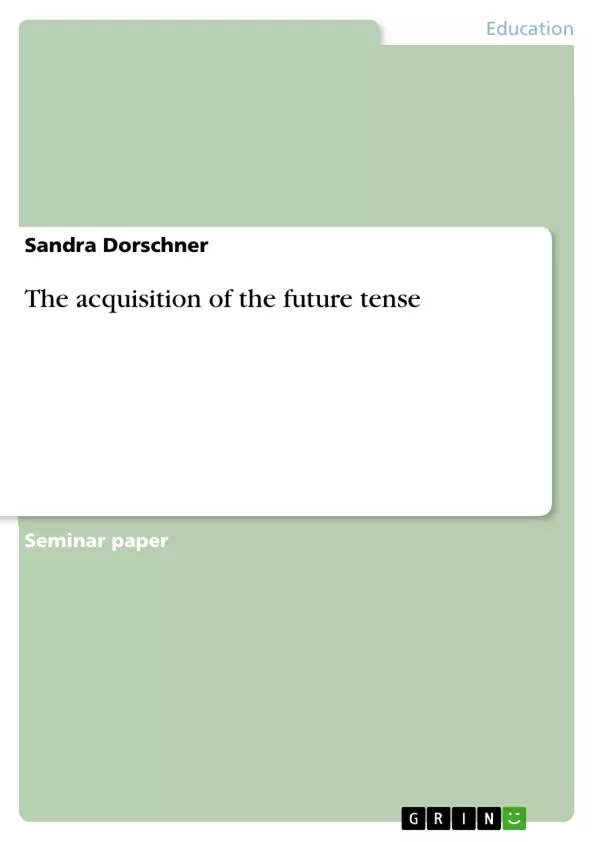It is the goal of this paper to examine the acquisition of the future tense in
children’s speech. After a two word utterance stage they develop more and
more their speaking skills and start to talk about events and activities in the
future, apart from saying things about the present. To give a detailed account
of the acquisition of the future, this study includes several steps of
examination. It will not only try to answer to the questions, when children first
use future expressions and how their use develops in time. But it also includes
an analysis of the occurrence of future tense in specific constructions, such as
simple sentences, questions etc. It is also necessary to look at verbs as well as
subjects which occur with expressions of future tense. A last part of the study
is concerned with common errors children produce when speaking about the
future.
There exist several ways to express the future in adult grammar. The most
common forms, which are also the focus of this analysis, are the simple future
expressed by will and the going to-future. Other possibilities of expressing the
future, e.g. using simple present tense or a present progressive form of the
verb, will be neglected in this paper, as they are too complex in their concepts
for children. They mainly depend on adverbials of time to denote the future
and therefore would require a different focus of analysis.
The simple future is formed with the modal auxiliary will, followed by the
infinitive of a verb (e.g. Greenbaum 1991: 54), as in
(a) I will write the exam.
The will-future is used to convey two different concepts: first, it is used for
expressing general predictions and assumptions of what is going to happen in
the future and second, it marks spontaneous decisions, offers and promises.
(cf. Fleischhack 2001: 70).
The second form of expressing future tense is the combination of the
infinitive of a verb with a form of be going to, such as in
(b) I am going to work in the garden.
Table of Contents
- Introduction
- Data
- Results
- General remarks on the data
- The age of acquisition of the future tense
- The development of the use of the future tense
- Constructions
- Subjects
- Verbs
- Errors in the use of the future tense
- Conclusion
Objectives and Key Themes
This paper aims to examine the acquisition of the future tense in children's speech. It investigates the age at which children begin to use future expressions, how their use develops over time, and analyzes the occurrence of future tense in specific constructions, subject-verb combinations, and common errors made by children. The paper focuses on the development of the will-future and gonna-future in spoken English.
- The age of acquisition of the future tense
- The development of the use of the future tense
- The occurrence of future tense in different constructions
- Subject-verb combinations in future tense constructions
- Errors in the use of the future tense
Chapter Summaries
The introduction provides an overview of the study's objectives, focusing on the acquisition of the future tense in children's speech. It discusses the different forms of expressing the future in adult grammar, particularly the will-future and going-to-future, and highlights the significance of analyzing the contracted form "gonna." The chapter concludes with a brief discussion of previous research on the future tense in English.
The "Data" chapter describes the data sources used in the study, which includes recordings of two children, Adam and Sarah, collected by Roger Brown between 1962 and 1966. The chapter provides details about the data collection process and the extent of the data.
The "Results" chapter presents the findings of the analysis. It includes sections on general remarks about the data, the age of acquisition of the future tense, the development of its use, constructions with gonna-future and will-future, subject-verb combinations, and errors in the use of the future tense.
Keywords
This study focuses on the acquisition of the future tense in children's spoken English, specifically the development of the will-future and gonna-future forms. It examines the age at which children begin to use future expressions, the evolution of their use, and the occurrence of future tense in specific constructions, subject-verb combinations, and common errors. The study draws on data from the CHILDES database, analyzing recordings of two children, Adam and Sarah, collected by Roger Brown.
- Citation du texte
- M.A. Sandra Dorschner (Auteur), 2006, The acquisition of the future tense, Munich, GRIN Verlag, https://www.grin.com/document/115383



